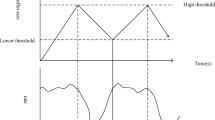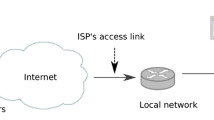Abstract
The paper proposes a set of features suitable for fine-grained traffic classification of network video, with data collected from real network. These features are parameters related to quality of experience (QoE), which reflects the user’s perception. The QoE value is calculated based on the ITU-T P.1201/Amd2 standard. Under this standard, each video flow can calculate corresponding QoE value and its probability of distribution. One innovative aspect of the paper is that the characteristics of QoE value and its probability distribution are extracted as the discriminating features which are suitable for video traffic classification. The extracted features of QoE distribution are typically mean, variance, maximum and minimum statistical characteristics, and the probability distribution of features can be obtained. Different from previous work, in our method, we obtain for the first time the discrete distribution of probability with five values, and use them directly as independent features to participate in feature selection and classification. The experimental results demonstrate that the proposed new features can significantly improve classification accuracy compared with an existing method.











Similar content being viewed by others
Explore related subjects
Discover the latest articles and news from researchers in related subjects, suggested using machine learning.References
Mehta, P., & Shah, R. (2017). A survey of network based traffic classification methods. Database Systems Journal, 7(4), 24–31.
Gomes, J. V., Inácio, P. R. M., Pereira, M., et al. (2013). Detection and classification of peer-to-peer traffic: A survey. ACM Computing Surveys (CSUR), 45(3), 30.
Xue, B., Zhang, M., Browne, W. N., et al. (2016). A survey on evolutionary computation approaches to feature selection. IEEE Transactions on Evolutionary Computation, 20(4), 606–626.
Bagherzadeh-Khiabani, F., Ramezankhani, A., Azizi, F., et al. (2016). A tutorial on variable selection for clinical prediction models: Feature selection methods in data mining could improve the results. Journal of Clinical Epidemiology, 71, 76–85.
Fahad, A., Tari, Z., Khalil, I., et al. (2013). Toward an efficient and scalable feature selection approach for internet traffic classification. Computer Networks, 57(9), 2040–2057.
Aldehim, G., & Wang, W. (2017). Determining appropriate approaches for using data in feature selection. International Journal of Machine Learning and Cybernetics, 8(3), 915–928.
Yuan, Z., & Wang, C. (2016). An improved network traffic classification algorithm based on Hadoop decision tree. In Proceedings of IEEE international conference of online analysis and computing science (ICOACS) (pp. 53–56).
Cao, J., Fang, Z., Qu, G., Sun, H., & Zhang, D. (2017). An accurate traffic classification model based on support vector machines. International Journal of Network Management, 27(1), 1–15.
Deng, Z., Zhu, X., Cheng, D., et al. (2016). Efficient kNN classification algorithm for big data. Neurocomputing, 195, 143–148.
Abedi, M., Norouzi, G. H., & Torabi, S. A. (2013). Clustering of mineral prospectivity area as an unsupervised classification approach to explore copper deposit. Arabian Journal of Geosciences, 6(10), 3601–3613.
Singh, H. (2015). Performance analysis of unsupervised machine learning techniques for network traffic classification. In Proceedings of fifth international conference on advanced computing and communication technologies (ACCT), (pp. 401–404).
Liu, Q., Sun, Y., Wang, C., et al. (2017). Elastic net hyper graph learning for image clustering and semi-supervised classification. IEEE Transactions on Image Processing, 26(1), 452–463.
Gan, H., Sang, N., Huang, R., et al. (2013). Using clustering analysis to improve semi-supervised classification. Neuro Computing, 101, 290–298.
Moore, A., Zuev, D. (2005). Discriminators for use in flow-based classification. London: Queen Mary University of London.
Wang, Z., Dong, Y., Shi, H., et al. (2016). Internet video traffic classification using QoS features. In Proceedings of 2016 international conference on computing, networking and communications (ICNC) (pp. 1–5).
Dong, Y., Zhao, J., & Jin, J. (2017). Novel feature selection and classification of Internet video traffic based on a hierarchical scheme. Computer Networks, 119, 102–111.
Dubin, R., Hadar, O., Richman, I., et al. (2016). Video quality representation classification of Safari encrypted DASH streams. In Proceedings of IEEE digital media industry and academic forum (DMIAF) (pp. 213–216).
Tseng, C. M., Huang, G. T., & Liu, T. J. (2016). P2P traffic classification using clustering technology. In Proceedings of 2016 IEEE/SICE international symposium on system integration (SII) (pp. 174–179).
Siris, V. A., Balampekos, K., & Marina, M. K. (2014). Mobile quality of experience: Recent advances and challenges. In Proceedings of IEEE international conference on pervasive computing and communications workshops (PERCOM workshops) (pp. 425–430).
Chen, Y., Wu, K., & Zhang, Q. (2015). From QoS to QoE: A tutorial on video quality assessment. IEEE Communications Surveys & Tutorials, 17(2), 1126–1165.
ITU-T Recommendation P.1201/Amd.2. (2012). Parametric non-intrusive assessment of audiovisual media streaming quality.
Wang, R., Geng, Y., Ding, Y., et al. (2014). Assessing the quality of experience of HTTP video streaming considering the effects of pause position. In Proceedings of 16th IEEE Asia-Pacific network operations and management symposium (APNOMS), (pp. 1–4).
Yu, P., Liu, F., Geng, Y., et al. (2015). An objective multi-layer QoE evaluation for TCP video streaming. In Proceedings of 2015 IFIP/IEEE international symposium on integrated network management (pp. 1255–1260).
Hoßfeld, T., Egger, S., Schatz, R., et al. (2012). Initial delay vs. interruptions: Between the devil and the deep blue sea. In Proceedings of fourth international workshop on quality of multimedia experience (QoMEX) (pp. 1–6).
Hall, M. A. (1999). Correlation-based feature selection for machine learning. Ph.D. dissertation, Waikato, New Zealand.
Charu C. Aggarwal. (2014). Feature selection for classification: A review. In Data classification: Algorithms and applications. London: Chapman and Hall/CRC Press.
Robnik-Šikonja, M., & Kononenko, I. (2003). Theoretical and empirical analysis of ReliefF and RReliefF. Machine Learning, 53(1–2), 23–69.
Acknowledgements
This work was supported in part by the National natural Science foundation of China (Nos. 61271233, 51401004, and 61601005), the Ph.D. Programs Foundation of Anhui Normal university (No. 2016XJJ129), Plan of introduction and cultivation of university leading talentsin in Anhui (No. gxfxZD2016013), and the HIRP program of Huawei technology Co. Ltd.
Author information
Authors and Affiliations
Corresponding author
Additional information
Publisher's Note
Springer Nature remains neutral with regard to jurisdictional claims in published maps and institutional affiliations.
Rights and permissions
About this article
Cite this article
Yang, L., Dong, Y., Rana, M.S. et al. Fine-Grained Video Traffic Classification Based on QoE Values. Wireless Pers Commun 103, 1481–1498 (2018). https://doi.org/10.1007/s11277-018-5864-5
Published:
Issue Date:
DOI: https://doi.org/10.1007/s11277-018-5864-5




